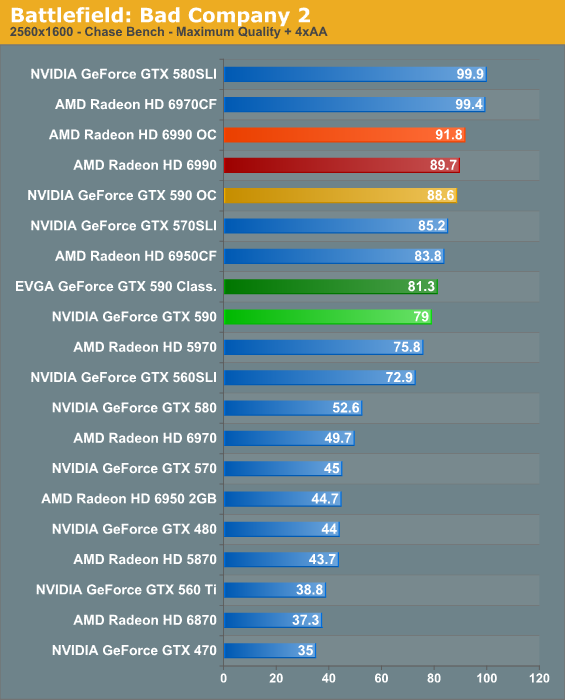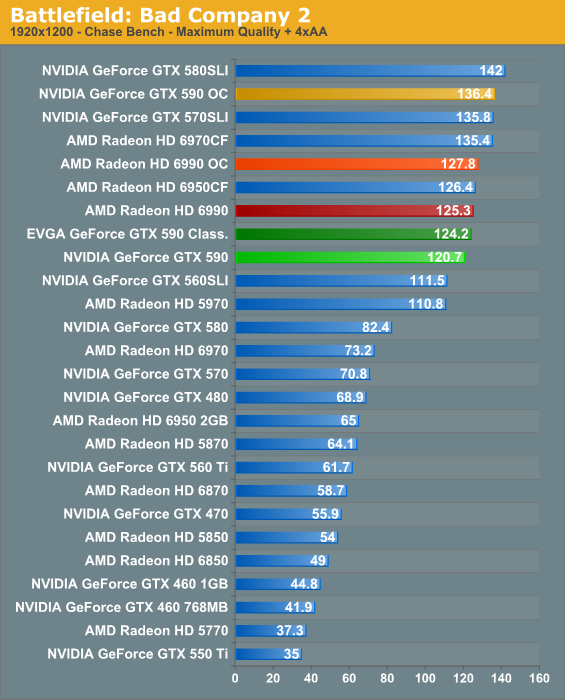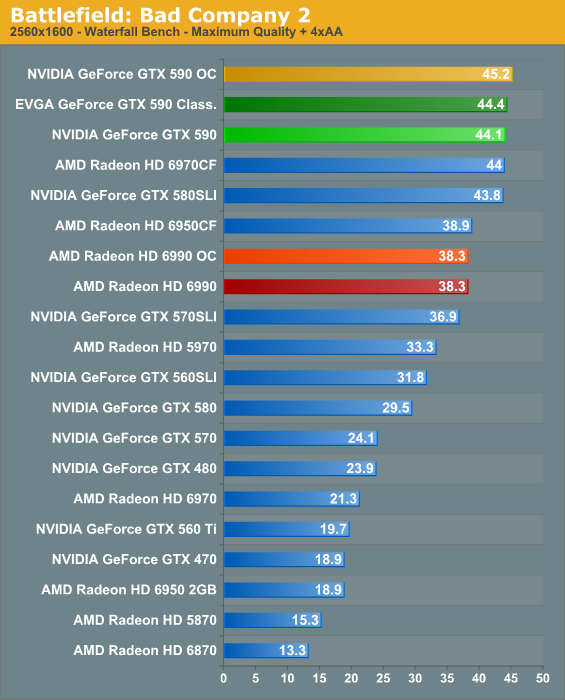NVIDIA’s GeForce GTX 590: Duking It Out For The Single Card King
by Ryan Smith on March 24, 2011 9:00 AM ESTBattlefield: Bad Company 2
Now approaching a year old, Bad Company 2 remains as one of the cornerstone DX11 games in our benchmark suite. Based on the Frostbite 1.5 engine, it will be replaced in complexity by the DX10+ only Frostbite 2 engine (and Battlefield 3) later this year. As BC2 doesn’t have a built-in benchmark or recording mode, here we take a FRAPS run of the jeep chase in the first act, which as an on-rails portion of the game provides very consistent results and a spectacle of explosions, trees, and more.


Historically Bad Company 2 favors two patterns in our tests: it favors shader speed, and it just favors AMD in general. Today is no exception, and while the GTX 590 can hit nearly 80fps, that’s still 10fps short of the 6990. Given that it’s normally shader bound our overclocked cards pick up the slack, but it’s not enough—not even the GTX 590 OC can reach the 6990, let alone an overclocked 6990.

Meanwhile our water benchmark gives us a good idea of what minimum framerates are like. Interestingly NVIDIA more than chips away at AMD’s lead here, and the GTX 590 and its overclocked variants top the charts. Given these scores it’s likely we’re approaching a non-GPU bottleneck in the game.










123 Comments
View All Comments
RaistlinZ - Thursday, March 24, 2011 - link
What about the 6950 2GB? It can be had for $245.00 after rebate and it's plenty powerful.the_elvino - Thursday, March 24, 2011 - link
Is it so hard to admit that the 6990's performance is better across the board? Multi-monitor setups were left out in order to make NVidia look good.Remember when the GTX 580 SLI review was published, AT didn't include a 5970 crossfire setup, because they sadly only had one 5970.
Yes, the GTX 590 is less noisy, but then again you can underclock the 6990 to GTX 590 performance levels and it will be quieter too, not really an argument.
The GTX 590 is slower (especially at super high resolutions) and draws more power than the 6990 at the same price, AMD wins! Simple!
softdrinkviking - Thursday, March 24, 2011 - link
If the 590 can only drive 2 displays, is the reason it has 3 DVI ports is only for people who buy 2 cards and then you can run all three off of one card?Ryan Smith - Friday, March 25, 2011 - link
The individual GPUs can only drive 2 monitors each. NVIDIA is using the display capabilities of both GPUs together in order to drive 4 monitors.softdrinkviking - Friday, March 25, 2011 - link
ah, got it. i should read more carefully.thanks for answering. :)
The Jedi - Friday, March 25, 2011 - link
Surely if each GPU can run two displays, two GPUs on one card can run four displays?Soulkeeper - Thursday, March 24, 2011 - link
Wow that is massiveI wouldn't put that in my pc if someone else bought it for me.
hab82 - Friday, March 25, 2011 - link
For me the gaming differences between AMD Nividia at this level would not get me to change allegiance. In my case I bought two EVGA classifieds but they may never see a game. I use them as low cost replacements to the Telsa cards. For Parallel processing I held off until we had powers of two ie 256 512 1024 cores. I did not like 240 432 480 alternatives. Just easier to work with powers of 2. The lower noise and lower power were big winners. Evan if the power supplies can handle them you still have to get the heat out of the room. My 4 nodes of 1024 cuda cores each are a pain to air condition in my den.I really love you gamers, you buy enough GPU's to keep the competition going and lowering the price for impressive computation power.
Thanks all!
Hubert
Calin - Friday, March 25, 2011 - link
USA manages to stay just south of Canadars2 - Friday, March 25, 2011 - link
I thought you guys learned your lesson the last time you pitted a factory-overclocked reference nVidia card against a stock AMD card. If you're going to use an overclocked card in an article that's meant to establish the performance baseline for a series of graphics cards (as this one does for the GTX 590 series), then you really should do at least one of:1. Downclock the overclocked "reference" card to stock levels.
2. Overclock the competing AMD card by a comparable amount (or use a factory overclocked AMD card as the reference point)
3. Publish a review using a card that runs at reference clocks, and then afterwards publish a separate review for the overclocked card.
4. Overclock both cards to their maximum stable levels, and use that as the comparison point.
Come on now, this is supposed to be Anandtech. It shouldn't be up to the readers to lecture you about journalistic integrity or the importance of providing proper "apples to apples" comparisons. Using a factory overclocked card to establish a performance baseline for a new series of GPU's is biased, no matter how small and insignificant the overclock may seem. Cut it out.